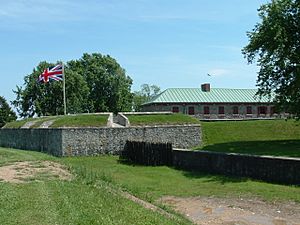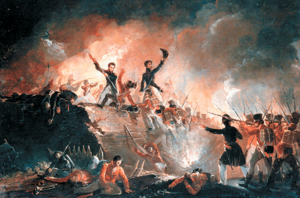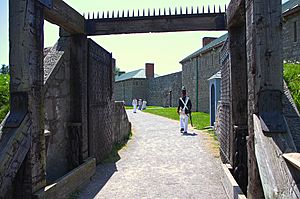Old Fort Erie facts for kids
Quick facts for kids Fort Erie National Historic Site of Canada |
|
|---|---|
 |
|
| Location | 350 Lakeshore Road Fort Erie, Ontario, Canada L2A 1B1 |
| Built | 1764 (original fort) 1805–1808 (present fort) |
| Original use | Military fort |
| Current use | Living museum |
| Governing body | Niagara Parks Commission |
| Lua error in Module:Location_map at line 420: attempt to index field 'wikibase' (a nil value). | |
| Designated: | May 28, 1933 |
Old Fort Erie is a very important historical place in Canada. It was the first fort built by the British after a big war called the Seven Years' War (also known as the French and Indian War). This war ended in 1763. After the war, France gave its lands east of the Mississippi River to Great Britain.
The fort is located in the town of Fort Erie, Ontario. It sits right across the Niagara River from Buffalo, New York in the United States. Today, the fort and the land around it are looked after by the Niagara Parks Commission. This group helps keep the fort open for everyone to learn about its past.
Contents
History of Fort Erie
The British built Fort Erie to help control their new lands. They also wanted to create a way to move supplies and people along the Niagara River and the Great Lakes.
Building the First Fort
The first fort was built in 1764. It was right by the Niagara River where a parking lot is now. This fort was a place to store supplies. It was also a port for ships carrying goods, soldiers, and travelers across Lake Erie. These ships were heading to the Upper Great Lakes.
By 1795, the fort had wooden blockhouses. These were strong buildings used for defense. A wooden fence, called a palisade, surrounded them. Supplies were kept inside the fort. There was also a large wooden building for gunpowder just outside.
Winter storms often damaged the fort. So, in 1803, plans were made for a new fort. This new fort would be built on higher ground behind the old one. It was designed to be bigger and stronger, made from a local stone called flintstone. However, it was not fully finished when the War of 1812 began.
The fort was also a supply base during the American Revolution. British soldiers, loyal American colonists, and Iroquois warriors used it.
Fort Erie During the War of 1812 (1812–1815)
Fort Erie saw some of the most intense fighting during the War of 1812. This war started on June 18, 1812, and the new fort was still being built.
In November 1812, some soldiers from Fort Erie fought against an American attack at the Battle of Frenchman's Creek. In 1813, American forces took control of Fort Erie for a while. But they left it on June 9, 1813. As they left, the small group of British and Canadian Militia soldiers partly took the fort apart.
The British returned to the area in December 1813 and tried to rebuild the fort. But on July 3, 1814, American soldiers landed nearby and captured Fort Erie again. The U.S. Army used the fort as a supply base. They also made its defenses even stronger.
After battles at Chippawa and Lundy's Lane, the American army went back to Fort Erie. The British then surrounded the fort for a long time, trying to take it back. This was called the Siege of Fort Erie.
On August 15, 1814, the British launched a big attack on the fort. But the American defenders were ready. An explosion in one part of the fort, called the North East Bastion, ruined the British attack. The British lost over 1,000 soldiers that day.
On September 17, American soldiers left the fort to attack British cannons. They managed to disable some of the cannons before returning to the fort. Soon after, the British stopped their siege and moved north. On November 5, 1814, as winter arrived, the Americans destroyed the fort and went back to Buffalo.
After the War (1814–1866)
The Treaty of Ghent was signed on December 24, 1814. This treaty officially ended the War of 1812. Even though the war was over, the British stayed at the ruined fort until 1823. They were worried about more American attacks.
Some of the stones from the fort were used to build St. Paul's Anglican Church in 1824. The church was rebuilt after a fire in 1892. Today, it is near the Niagara Parkway, about 3 kilometers (1.9 miles) north of the fort. The town of Fort Erie began to grow north of the fort. This happened when a train station was built in the area.
Fenian Raids (1866)
The Fenians were Irish-American soldiers who fought in the American Civil War. They wanted Ireland to be free from Britain. They launched several attacks, called Fenian Raids, on Upper Canada.
One large raid happened on June 1, 1866. Between 1,000 and 1,500 Fenian soldiers crossed the Niagara River and attacked Fort Erie. They took over the town and asked for food and horses. They even cut telegraph wires and tore up some railway tracks.
The Fenians then marched to Chippewa and later to Ridgeway. There, they fought against the Canadian militia in the Battle of Ridgeway. The Fenians returned to Fort Erie and defeated a small group of Canadian militia.
However, they could not get more soldiers from across the river. American forces were guarding the river. Also, a large group of British and Canadian soldiers was coming. So, the Fenian leader decided to go back to the U.S. About 850 Fenian soldiers surrendered to the American navy. This was the last major Fenian raid on Upper Canada.
Fort Erie Today (1866–Present)
After the Fenian Raids, the fort was left empty. Parts of its walls and buildings still stood. Eventually, it was sold to the Niagara Parks Commission in 1901.
The fort's reconstruction began in 1937. This project helped create jobs during the Great Depression. The fort was rebuilt to look like it did during the 1812-1814 period. It officially reopened on July 1, 1939. During the restoration, a mass grave was found. It contained the remains of 150 British and 3 American soldiers. A monument was placed there in 1904 to remember them.
The Niagara Parkway was built starting at Fort Erie. It stretches 56 kilometers (35 miles) north to Lake Ontario. Sir Winston Churchill once called it "the prettiest Sunday drive in the world."
Every year in August, many people gather at the fort. They dress up in old uniforms and re-enact the siege of Fort Erie. This helps visitors imagine what life was like during those historical times.
In 1985, Canada Post released a stamp featuring 'Fort Erie, Ont.' It was part of a series called "Forts Across Canada."
Affiliations
The Fort Erie Museum works with:
See also
 In Spanish: Old Fort Erie para niños
In Spanish: Old Fort Erie para niños
- Fort George
- Fort Meigs
- Fort Mississauga
- List of forts




